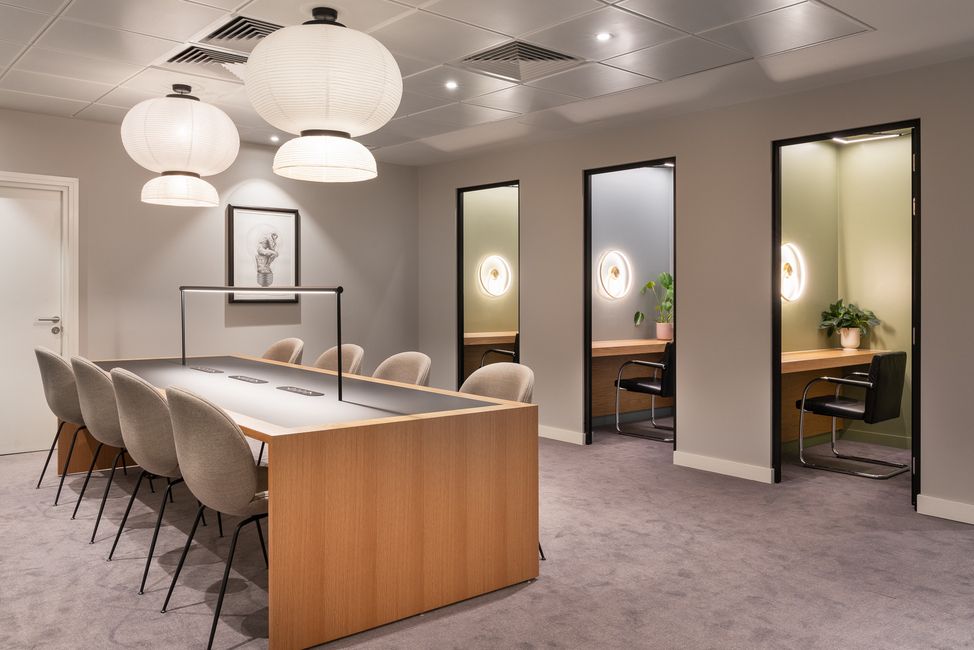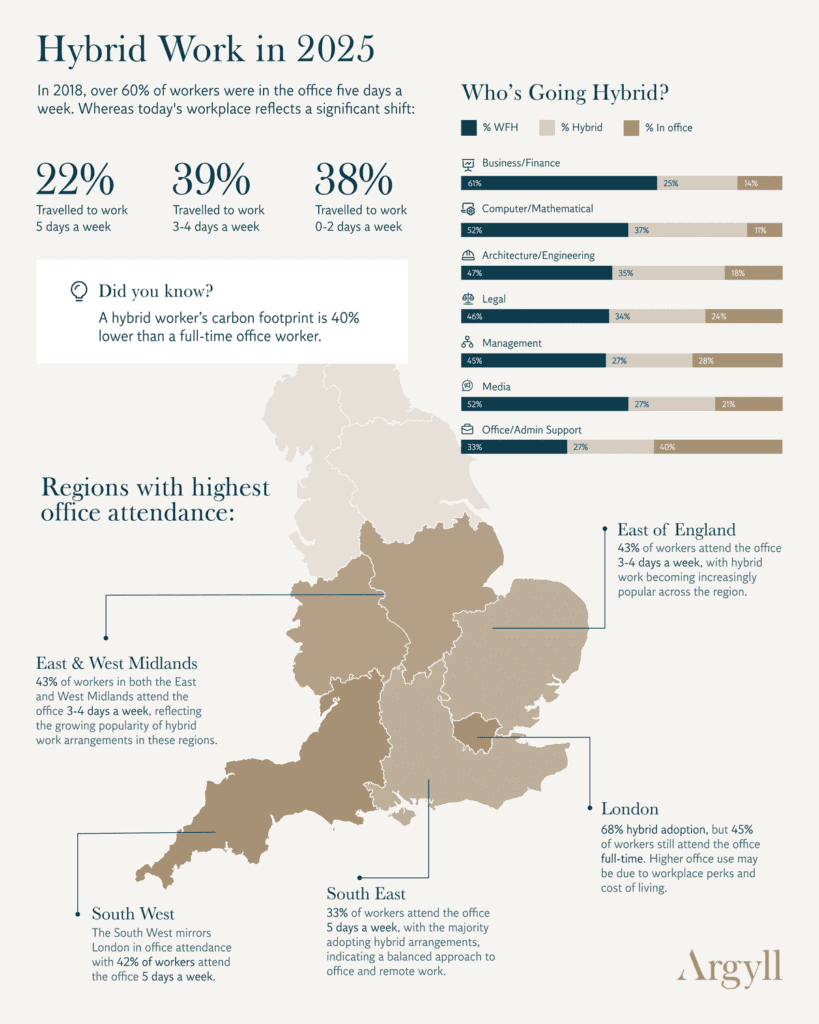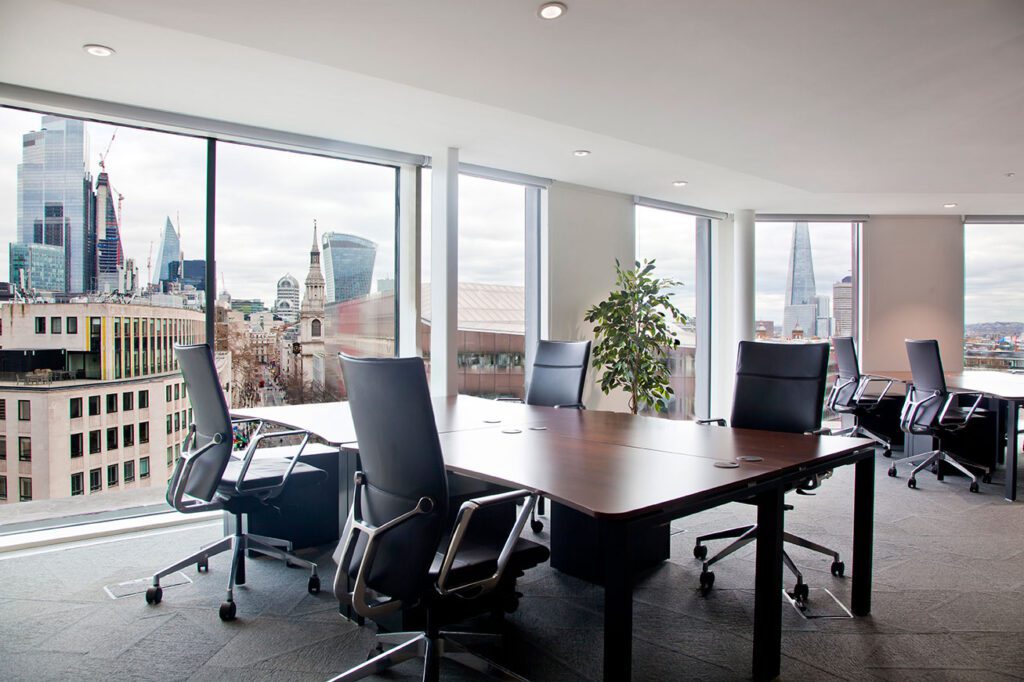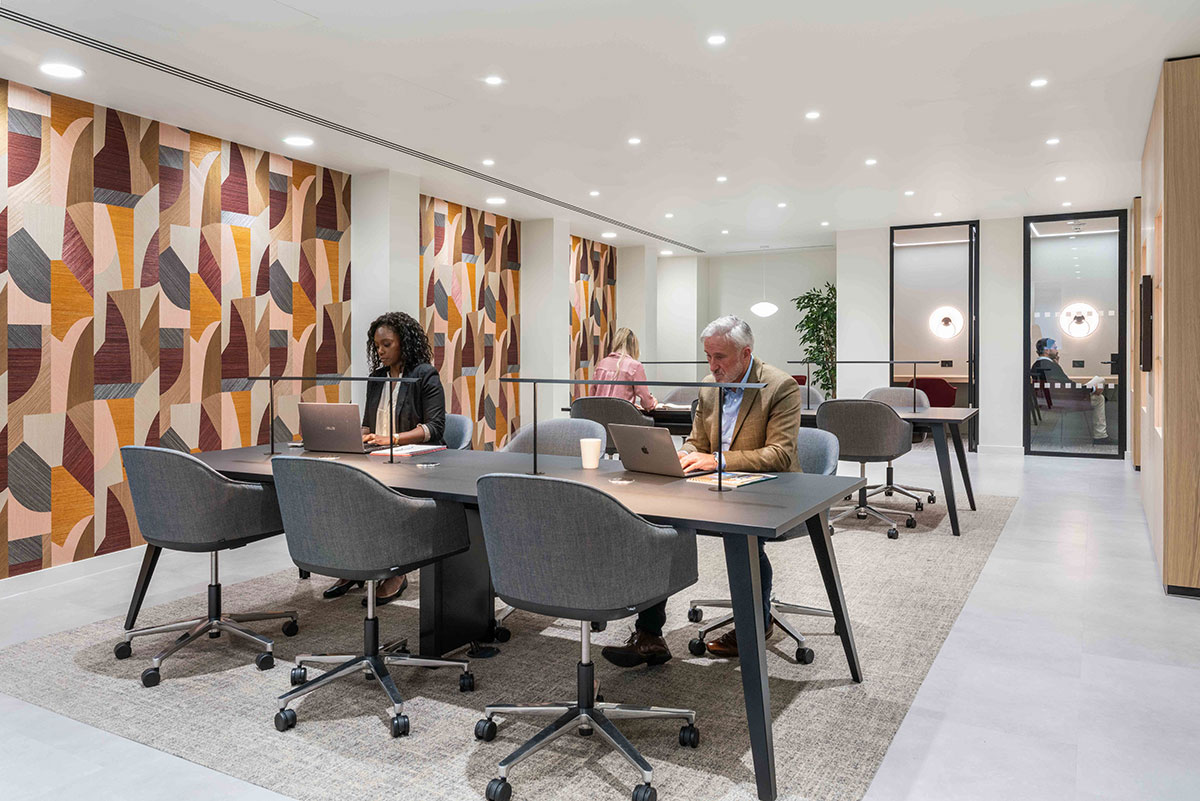As the world of hybrid work continues to evolve, having data-driven insights at your fingertips is key to making informed decisions about your ideal workspace. Our analysis of the latest hybrid work trends highlights key regional differences and how different work styles are emerging across industries, shaping the way individuals choose to work.
Understanding these shifting workplace patterns can give you a distinct advantage in finding a private office space that perfectly suits your needs. With deeper insight, you can design a work environment that supports your productivity, job requirements, and work-life balance.
At Argyll, we have a collection of exceptional workspaces to suit your hybrid working preferences. We are committed to delivering top-quality services so that you can boost your efficiency, increase your job satisfaction and create a setup that fuels your success.
Key hybrid work statistics
- Only 22% of workers attend the office 5 days per week.
- London shows higher rates of hybrid employees (68%) compared to more rural areas.
- A typical hybrid worker’s carbon footprint is approximately 40% lower than traditional office-only arrangements.
- 74% of tech companies and 61% of financial institutions implement formal hybrid working policies.
- Professional services firms, including consulting and legal practices, follow closely at 58% adoption rates.
- There is significant variation between the use of traditional office space between persona types – only 16% of Innovator personality types attend the office 5 days per week, compared to 64% of Maximiser personas.
The new office reality: How attendance is changing
In 2018, over 60% of workers were office-based five days a week, whereas today’s workplace reflects a significant shift. Most employees now come to physical workplaces just 3-4 days weekly, with a third of office workers attending in person only 0-2 days per week.
Let’s break down the stats:
- 38% attend the office 0-2 days a week
- 39% attend the office 3-4 days a week
- 22% attend the office 5 days a week
Source: Resonate, State of the Workplace Report
The modern workplace has undergone a fundamental transformation in how employees interact with physical office spaces. The office is no longer simply a location for daily, full-time attendance. Instead, offices now act as collaborative hubs accessed strategically throughout the working week by hybrid workers who choose when they want to attend.
This shift reflects employees’ growing preference for structuring their working week around specific in-office activities. Workers are now more likely to attend the office for collaborative meetings, brainstorming sessions, and client interactions, while they reserve days working from home for more focused individual work.

Industry breakdown: Who’s going hybrid?
So, which industries are more likely to adopt a hybrid working model? Our analysis of hybrid work data shows that industries with knowledge-based workforces have embraced hybrid work models at significantly higher rates than others.
- Technology and financial services lead this adoption, with 74% of tech companies and 61% of financial institutions implementing formal hybrid policies.
- Professional services firms, including consulting and legal practices, follow closely at 58% adoption rates (Gartner Workplace Survey, 2024).
- Education and manufacturing sectors show the lowest adoption rates at 29% and 18% respectively, though even these industries are experimenting with hybrid working arrangements for certain job functions (Microsoft Work Trend Index, 2024).

Image Data Sources: LinkedIn, Resonate & Statista
Regional trends: Where hybrid work is growing fastest
Geographic location significantly influences hybrid work adoption patterns across the UK. London and the South West of England reveal notably higher office attendance rates compared to other areas where working remotely and hybrid arrangements remain more prevalent. The North of England sees almost half of workers attending the office 3-4 days a week, with similar ratios of hybrid work arrangements proving popular in Scotland and Northern Ireland.
Workplace expectations appear increasingly tied to geographic and economic factors. In the capital, a substantial 45% of workers report returning to office settings five days a week, with London’s higher cost of living perhaps contributing to workers seeking to maximise the use of London office spaces and amenities.
Working in an Argyll central London office provides employees with unparalleled convenience to essential services and lifestyle amenities. Within moments of leaving their workplace, staff can access post offices and banks for personal errands, browse high street retailers and boutique shops during lunch breaks, and enjoy world-class cultural attractions like theatres after hours.
Who benefits from hybrid working?
Whilst many workers prefer the flexibility of hybrid work models, some employers query the level of employee productivity when working from home, which can create discord. Transparency is key – opening up a conversation about expectations can generate trust and give employees the confidence to embrace their version of flexible hybrid work.
Some employees cite work-life balance, focus time, and meetings as reasons to go into the office. Others see those as reasons to work from home. With a greater understanding of work data and which personas benefit from hybrid working, managers are better placed to meet the needs of their hybrid workforce.
Here, we look at different personality types and the kind of working model that is best for them. This gives us a greater understanding to better facilitate hybrid work environments and increase productivity for each of the persona sectors.

Persona profile expert insights
Innovators
Innovators are typically 18-35 years old, and are characterised by their forward-thinking approach and adaptability. Usually found in the creative/design or IT sectors, these individuals thrive on creative problem-solving and view the hybrid work model as an opportunity rather than a challenge.
Wellness seekers
The wellness seekers view hybrid work primarily through the lens of how it can support their physical, mental, and emotional health. Most commonly in the 25-44 year age bracket and attending office environments 1-2 times a week, wellness seekers carefully manage boundaries between work and personal life.
Maximisers
Maximisers constitute approximately 26% of knowledge workers in the Gen X/older millennials age bracket, with higher concentrations in competitive fields like consulting, finance, and technology. These individuals approach hybrid work strategically, seeking to optimise every aspect of their professional experience.

Hybrid working trends: What do these personas seek?
The way an employee prefers to work says a lot about when they’re more likely to show up at the office. Forward-thinking companies are noticing these patterns and adapting their spaces accordingly.
Innovators: Change, technology & flexible spaces
Innovators tend to be highly engaged regardless of location, showing similar productivity levels, whether remote or in-office. Innovators particularly value flexibility not just in where they work but in when and how they work. Our analysis of the latest hybrid work data shows that innovator personality types will most likely attend the office 3-4 days a week.
Wellness seekers: Wellbeing and work-life balance
Wellness seekers represent 40% of the workforce, highlighting a need to improve office conditions to attract wellness seekers back into the office. Creating a space with high-speed internet, privacy, tidy kitchens and flexible noise control can reflect their experience at home and encourage them back into an office environment.
Maximisers: Efficiency and productivity
Around five years ago, 87% of maximisers worked in the office five days a week, but that number has now dropped to 64%. Maximisers value stability and structure, often working 4-5 days a week in traditional office settings. Maximisers may also prefer to hire private meeting rooms to address their privacy concerns and preference for noise level reduction.
Office attendance: Persona types
Recent research by Resonate has discovered that office attendance varies depending on persona types. Using the information below, you can structure your business working patterns and environment to suit various individuals by hiring flexible office spaces and ensuring your team reaches its full potential.
Innovator attendance
- 16% attend the office 5 days per week
- 51% attend the office 3-4 days per week
- 32% attend the office 1-2 days per week
Wellness seeker attendance
- 47% attend the office 3 days per week
- 36% attend the office 2 days per week
- 18% attend the office 1 day per week
Maximiser attendance
- 64% attend the office 5 days per week
- 36% attend the office 4 days per week
How office use has changed for each persona profile
Innovator trends
Innovators have ditched consistent office presence in favour of more diverse working environments. They are pioneers of the “work-from-anywhere” approach, with over half reporting they’ve worked from three or more countries in the past year—triple the pre-pandemic rate.
Wellness seeker trends
Wellness Seekers have shifted from reluctant full-time office attendance to more boundary-focused hybrid schedules. They’re the primary drivers behind the growing demand for biophilic office design, with the majority reporting they select in-office days based on access to natural light, outdoor spaces, and wellness amenities.
Maximiser trends
Maximisers show a preference for “high-value days” and tend to coordinate office visits specifically when leadership is present. This persona type concentrates collaborative work into fewer, more intensive in-person sessions to maximise their time spent in the office.
Other rising trends
People crave connection, and the one negative of remote working is that the personal connection is lost. As a result, companies are seeing colleagues making agreements on shared in-office days to maximise face time and better manage space requirements. This collaboration can make a hybrid workplace thrive and see more employees report for work in a real-life work environment.
How personas use hybrid office spaces differently
| Persona Type | Likes | Dislikes |
| Investor | High tech environments Privacy & noise reduction Healthy snacks | Limited space Loud noise and interruptions Too many food & drink options |
| Wellness Seeker | High tech environments Fresh, clean, hygienic environments Personal desk | Limited space Overcrowding Too many food & drink options |
| Maximiser | High tech environments Fresh, clean, hygienic environments Free drinks available | Limited space Outdated facilities Loud noise levels |
What drives people back to the office?
The office provides unique benefits that many find difficult to replicate at home. Beyond simply having a change of scenery, employees are returning to offices for meaningful human connection, spontaneous collaboration, and access to resources that enhance their work experience.
Collaborating with colleagues
There’s something special about working side-by-side with teammates that video calls just can’t match. Those quick, unplanned conversations while grabbing coffee often spark the best ideas. Many workers miss the energy of brainstorming sessions where everyone can build off each other’s thoughts in real-time.
The office creates natural opportunities for mentorship, where newer team members can observe how experienced colleagues handle challenges. Even just overhearing others discuss projects can provide valuable insights that might otherwise be missed in the isolation of remote work.
Team meetings
While virtual meetings serve their purpose when necessary, many teams find that gathering in the same room creates a different dynamic. It’s easier to read the room, notice who might have something to contribute but hesitates to speak up, and truly engage without the distractions of home.
Physical meetings tend to have fewer technical issues and allow for a more natural conversation flow without the awkward pauses common in video calls. Plus, there’s the added benefit of casual conversations that happen before and after the official meeting—those moments where team bonds strengthen and additional insights emerge.
Work-life balance
Surprisingly, many people find that going to an office actually improves their work-life balance rather than hindering it. Having a physical separation between work and home helps create clearer boundaries, making it easier to truly disconnect at the end of the day.
The commute, while sometimes challenging, serves as a transition period that allows people to mentally prepare for work or decompress afterwards. Office environments also provide social outlets that support wellbeing, from lunch with colleagues to after-work activities that build connections. For those with demanding home situations or limited space, the office offers a dedicated work environment free from domestic distractions.
Addressing the pain points of hybrid working
The transition to hybrid work hasn’t been without challenges. The most successful organisations view these pain points not as reasons to abandon hybrid work, but as opportunities to refine their approach.
Many organisations struggle with creating truly equitable experiences between remote and in-office employees, particularly during meetings where remote participants can feel like second-class contributors.
The blurred boundaries between work and personal life remain problematic for some hybrid workers, with employees reporting longer hours and difficulty disconnecting. Forward-thinking companies are tackling these issues by investing in better hybrid meeting technology, implementing company-wide coordination days, establishing clear communication protocols, and encouraging managers to model healthy work-life separation.
What do workers say about the hybrid work environment?
Hybrid work data reveals a nuanced blend of appreciation and ongoing challenges for employees. Most employees express gratitude for the flexibility hybrid arrangements provide, giving them a good work-life balance and job satisfaction. They describe hybrid work as a positive evolution rather than a temporary measure.

Exceptional workspaces for hybrid workers
Here at Argyll, we’ve been creating exceptional hybrid work environments since 1996, so we know a thing or two about the benefits, policies and culture that earned us a Great Place to Work certification and a place on The Sunday Times Best Places to Work list in 2024.
Exceptional service has shaped our signature experience of private offices, meeting rooms and event spaces in London’s finest locations for over 25 years. We address the unique needs of today’s hybrid workforce by creating environments that blend the best aspects of traditional offices with the flexibility modern professionals demand.
Our offices address the core challenges of hybrid work, while enhancing the benefits that draw people back to shared workspaces. By combining professional-grade technology, hospitality-inspired service, and thoughtfully designed spaces, Argyll creates workplaces where businesses can thrive.
If you’d like to know more about our office environments or want to arrange a tour of one of our locations, our team is ready to help. Call 020 300 88888, and speak to a member of the team today.
FAQs
Are hybrid workers happier?
Yes, hybrid workers consistently report higher satisfaction levels and experience better work-life balance, reduced commuting stress, and greater autonomy while maintaining meaningful workplace connections.
How many people want to work hybrid in 2025?
The majority of knowledge workers—approximately 74%—express a preference for hybrid arrangements in 2025. This indicates how hybrid models have evolved from a temporary solution to a permanent workplace preference across generations and industries.
What percentage of the UK is working hybrid?
The majority of knowledge workers—approximately 74%—express a preference for hybrid arrangements in 2025. This indicates how hybrid models have evolved from a temporary solution to a permanent workplace preference across generations and industries.
How effective is a hybrid workplace?
Hybrid workplaces can be highly effective when thoughtfully implemented. Organisations with clear coordination policies, appropriate technology infrastructure, and redesigned office spaces report productivity increases averaging 15-22% over past experiences.
Is hybrid work more environmentally sustainable?
Yes, hybrid work models generally reduce environmental impact through decreased commuting, lower office energy consumption, and reduced commercial real estate needs. A typical hybrid worker’s carbon footprint is approximately 40% lower than traditional office-only arrangements.




